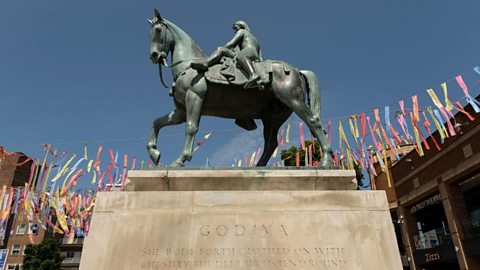When is a legend not a legend?
That’s a pretty complicated question to answer, but history has examples of people and events where reality has been intertwined with other stories over the years - to the extent it becomes difficult to separate what's true from what isn’t.
≥…»ÀøÏ ÷ Bitesize looks at the stories behind three famous names to see how close to the truth our knowledge of them really is.
Did Lady Godiva ride naked through the streets of Coventry?
It has long been told that Lady Godiva was so concerned over taxes imposed on the people of Coventry, that she continually begged her husband Leofric, the Earl of Mercia, to do something about it.
An annoyed Leofric said he would consider it if she rode naked on horseback through the city’s busy marketplace. Lady Godiva was supposedly so passionate about her cause, she did just that - with her long flowing hair covering her body as she rode through the town. True to his word, Leofric cancelled all taxes, except for those on horses.

Or did he? Did Lady Godiva even take part in the ride? The monk Florence of Worcester was a historian alive at the same time as Lady Godiva and the Earl of Mercia. He recorded current events and, while his work references the couple, there is no mention of any protest on horseback.
It only appears to be in later chronicles that the horse ride is mentioned. Roger of Wendover, another historian, wrote the earliest example of the Lady Godiva on horseback story, around a century after her death.
However, Roger of Wendover was noted by historians as someone who would stretch the truth in his works, so there’s a good chance the legend is just that. It doesn’t stop Coventry proudly celebrating the story, though. An ornamental clock in the city recreates the horse ride in mechanical form, an annual music festival bearing Lady Godiva’s name is held in the War Memorial Park and the legend played a part in Coventry's UK City of Culture celebrations in 2021.
Did a man called Robin Hood really steal from the rich?
A bandit based in a forest with a merry gang of companions. A uniform of Lincoln green. Stealing from the rich, then handing it over to the poor. The legend of Robin Hood has been irresistible to storytellers for centuries.
Robin’s adventures against the Sheriff of Nottingham appear as far back as the 14th Century. But it was Sir Walter Scott’s 1820 novel Ivanhoe that really aroused people’s interest. Set in England in 1194, it described the “king of outlaws” as an honourable man with loyalties to the ‘other’ king (Richard I, the then monarch).

Historians delving deeper into the Middle Ages have uncovered more than one man called Robin Hood, concluding that Robin Hood was instead an alias, used by different outlaws over an extended period of more than 100 years.
So while we can find record of a man (or several men) known as Robin Hood existing, we sadly can’t confirm if they wore green by choice or regularly handed out stolen goods to those in need. Still, it makes for great songs, books, films and TV.
Was Dick Turpin really a charismatic highwayman?
Unlike Robin Hood, we know that Dick Turpin, the 18th Century highwayman of adventure-packed literature, definitely existed. Folklore tells Turpin as a charismatic, gentlemanly rogue who once rode his horse, Black Bess, from London to York in just one day.
It’s simply not true.
The Dick Turpin of films and TV is mainly based on the version that appears in Rookwood, an 1834 novel by William Harrison Ainsworth.

The real Turpin was involved with the Gregory Gang, a notorious and violent group of robbers. Far from the glamorous deeds of romantic fiction, Turpin’s list of crimes grew, including murder.
Justice caught up with him by chance. He was in prison for another crime under the assumed name of John Palmer, and was caught out after writing to his brother. A former schoolteacher saw the letter and recognised the handwriting as Turpin’s. With the infamous criminal unmasked, he was sentenced to death and executed in 1739. So unpopular was he by this point, Turpin paid mourners to watch his sentence carried out.
The legend of Dick Turpin became so embellished over the years, he arguably committed another theft long after his death. The ‘honour’ of completing the 200-mile horse ride between London and York was stolen from the man who actually did it - another highwayman, John Nevison.
This article was published in August 2022.
Eight blockbuster films that got history wrong
Some of these are Oscar winners too, but they're not getting any prizes for knowing their history.

The classic novels opening line quiz
It was the best of challenges, it was the worst of challenges.

What does Star Wars get right about physics?
Don't worry, there's plenty it gets wrong too.
